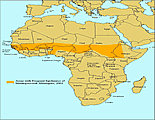|
Meningococcal Disease
Description
Meningococcal disease is an acute bacterial disease
characterized by sudden onset with fever; intense headache; nausea
and often vomiting; stiff neck; and, frequently, a petechial rash
with pink macules. Formerly, the case-fatality ratio exceeded 50%
but, with early diagnosis, modern therapy, and supportive measures,
the case-fatality ratio is about 10%. In addition, approximately
13% of survivors have long-term sequelae, including hearing loss,
mental retardation and loss of limbs. Up to 10% of populations in
countries with endemic disease carry the bacteria asymptomatically
in their nose and throat.
Occurrence
In sub-Saharan Africa, peaks of serogroup A meningococcal
disease occur regularly during the dry season (December through June).
In addition, major epidemics occur every 8–12 years, particularly
in the savannah areas extending from Mali eastward to Ethiopia, known
as the “meningitis belt” (see
Map 3–7). In 2000, a serogroup W-135 epidemic
occurred in Saudi Arabia in association with the Hajj pilgrimage.
Cases also occurred in returning pilgrims and their families, including
several cases in the United States. In 2002, a major epidemic due
to serogroup W-135 occurred in Burkina Faso.
| Map
3–7. Areas with frequent epidemics of meningococcal
meningitis, 2002 |

View
enlarged map |
|
Risk for Travelers
Travelers to sub-Saharan Africa may be at risk for
meningococcal disease. Because of the lack of established surveillance
and timely reporting from many of these countries, travelers to the
meningitis belt during the dry season should be advised to receive
meningococcal vaccine, especially if prolonged contact with the local
population is likely.
Prevention
Vaccination against meningococcal disease is not
a requirement for entry into any country, except Saudi Arabia, for
travelers to Mecca during the annual Hajj. Vaccination is indicated
for travelers to countries recognized as having epidemic meningococcal
disease caused by a vaccine-preventable serogroup (i.e., A, C, Y,
and W-135) during the dry season. Advisories for travelers to other
countries will be issued when epidemics of meningococcal disease
caused by vaccine-preventable serogroups are recognized. (See the
CDC Travelers' Health website at http://www.cdc.gov/travel/outbreaks.htm.)
Serogroup A is the most common cause of epidemics
outside the United States, but serogroups C and B can also cause
epidemic disease. One formulation of meningococcal polysaccharide
vaccine is currently available in the United States: quadrivalent
A, C, Y, and W-135 vaccine (Table 3–12).
The vaccine, which is available in single- and 10-dose vials, is
distributed in the United States by Aventis Pasteur. No vaccine is
yet available to offer protection against serogroup B. Meningococcal
vaccines are chemically defined antigens consisting of purified bacterial
capsular polysaccharides, each inducing serogroup-specific immunity.
Serogroup A vaccine has not been shown to be effective in infants <3
months of age and can be less than fully effective in infants 3–11
months of age. Serogroup C vaccine has not been shown to be effective
in infants <2 years of age. The group Y and W-135 polysaccharides
have been shown to be safe and immunogenic in adults; the response
of infants to these polysaccharides is unknown. A study in 2001 among
U.S. Hajj pilgrims found that pathogenic meningococcal nasopharyngeal
carriage was uncommon in this vaccinated population;[2] CDC does
not currently recommend antimicrobial chemoprophylaxis for returning
pilgrims.
Table 3–12.
Meningococcal vaccine
| Quadrivalent A,C,Y,W-135,
for subcutaneous injection |
0.5 mL |
Duration of immunity is unknown,
but appears to be at least 3 years in those 4 years
of age or older. Revaccination after 2–3 years
should be considered for children first vaccinated
at <4 years of age who continue to be at high
risk. |
|
|
Adverse Reactions
Adverse reactions to meningococcal vaccine are infrequent
and mild, consisting principally of localized erythema that lasts
1–2 days. Transient fever may develop in up to 2% of infants
after vaccination.
Precautions and Contraindications
Studies of vaccination during pregnancy have not
documented adverse effects among either women or neonates (1 month
of age and younger). Based on data from studies
involving the use of meningococcal vaccines and other polysaccharide
vaccines administered during pregnancy, altering meningococcal vaccination
recommendations during pregnancy is unnecessary.
— Nancy
Rosenstein
|

